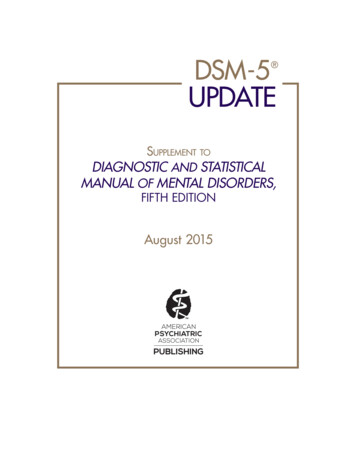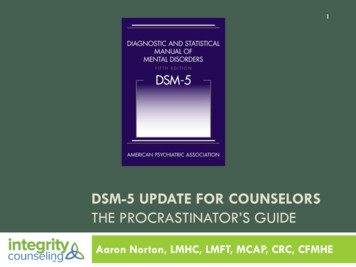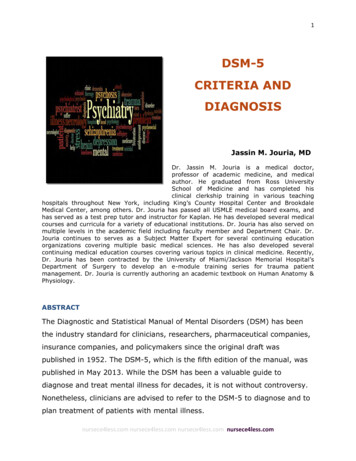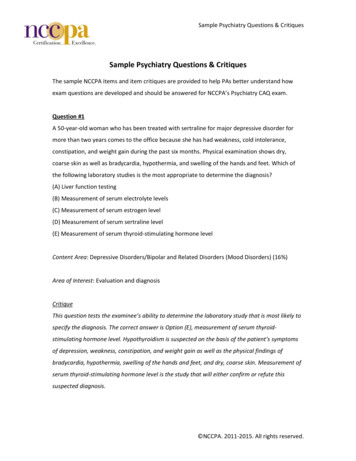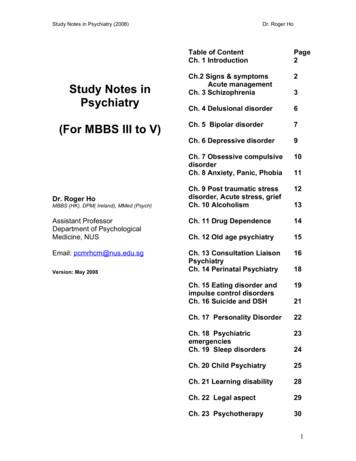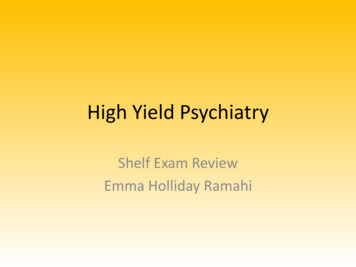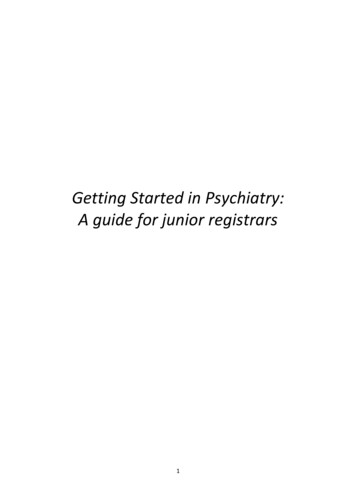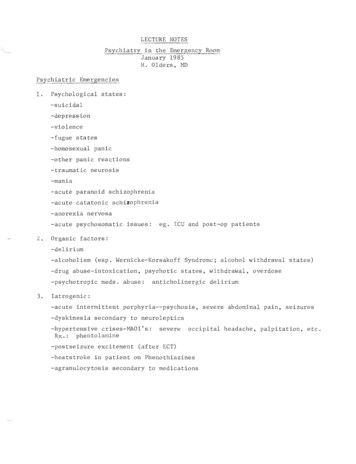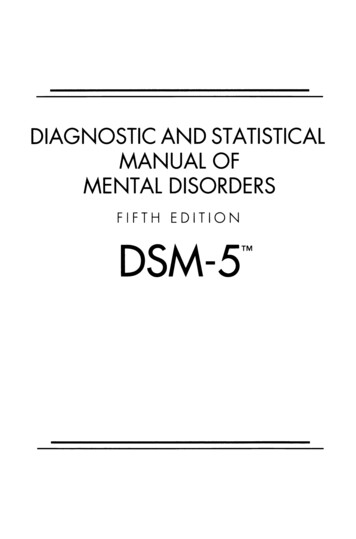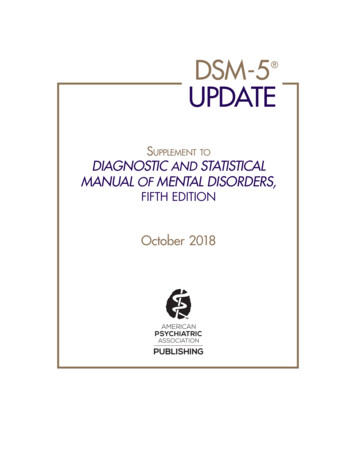
Transcription
DSM-5UPDATE Supplement toDIAGNOSTIC AND STATISTICALMANUAL OF MENTAL DISORDERS,FIFTH EDITIONOctober 2018
DSM-5 UpdateOctober 2018Supplement toDiagnostic and Statistical Manual of Mental Disorders, Fifth EditionCopyright 2018 American Psychiatric Association. All rights reserved. Unless authorized inwriting by the American Psychiatric Association (APA), no part of this supplement may bereproduced or used in a manner inconsistent with the APA’s copyright. This prohibition applies tounauthorized uses or reproductions in any form, including electronic applications.Correspondence regarding copyright permissions should be directed to DSM Permissions,American Psychiatric Association Publishing, 800 Maine Ave. SW, Suite 900, Washington, DC20024-2812.This supplement and the digital versions of DSM-5 (including the DSM-5 Diagnostic CriteriaMobile App, DSM-5 eBook, and DSM-5 on PsychiatryOnline.org) reflect any updates to diagnosticcriteria and related text; coding updates, changes, or corrections; and any other informationnecessary for compensation in mental health practice. This supplement contains ICD-10-CMupdates that become effective on October 1, 2018. It also includes content from prior updatesthat remains relevant to compensation and current clinical practice. This supplement is located at:https://psychiatryonline.org.DSM and DSM-5 are registered trademarks of the American Psychiatric Association. Use of theseterms is prohibited without permission of the American Psychiatric Association.ICD-9-CM codes were used for coding purposes in the United States through September 30,2015. Because ICD-9-CM codes can no longer be used in the United States, they are notincluded in this DSM-5 Update. ICD-10-CM codes are used for coding purposes in the UnitedStates as of October 1, 2015.
ContentsOctober 2018 ICD-10-CM Coding Updates at a Glance .1Prior ICD-10-CM Coding Updates at a Glance (2015–2017) .2October 2017 ICD-10-CM Coding Updates at a Glance .2October 2016 ICD-10-CM Coding Updates at a Glance .6October 2015 ICD-10-CM Coding Updates at a Glance .7Criteria Updates .8Neurodevelopmental Disorders .8Autism Spectrum Disorder: Criterion A [August 2015]Schizophrenia Spectrum and Other Psychotic Disorders.8Brief Psychotic Disorder: “With Peripartum Onset” Specifier [August 2015]Substance/Medication-Induced Psychotic Disorder: Coding Note [October 2018]Bipolar and Related Disorders .9Bipolar I Disorder: Manic Episode, Criterion A [August 2015]Bipolar I Disorder: Hypomanic Episode, Criterion F [August 2015]Bipolar I Disorder: “With Psychotic Features” Specifiers [October 2018]Bipolar II Disorder: Hypomanic Episode, Criterion F [August 2015]Bipolar II Disorder“With Melancholic Features” and “With Atypical Features” Specifiers [August 2015]“With Psychotic Features” Specifiers [October 2018]“With Seasonal Pattern” Specifier [August 2015]Severity Specifier [August 2015]Substance/Medication-Induced Bipolar and Related Disorder: Coding Note [October 2018]Specifiers for Bipolar and Related Disorders:“With Psychotic Features” Specifiers [October 2018]Severity Specifiers [August 2015]Depressive Disorders .14Substance/Medication-Induced Depressive Disorder: Coding Note [October 2018]Other Specified Depressive Disorder [October 2018]Unspecified Depressive Disorder [October 2018]Specifiers for Depressive Disorders:“With Mixed Features” Specifier, Criterion A [August 2015]“With Seasonal Pattern” SpecifierCriterion B [October 2018]Criterion D Note [August 2015]Anxiety Disorders .16Substance/Medication-Induced Anxiety Disorder: Coding Note [October 2018]Other Specified Anxiety Disorder [October 2018]Unspecified Anxiety Disorder [October 2018]Obsessive-Compulsive and Related Disorders .17Substance/Medication-Induced Obsessive-Compulsive and Related Disorder:Coding Note [October 2018]
Trauma- and Stressor-Related Disorders .17Acute Stress Disorder: Criterion A [October 2018]Adjustment Disorder: Addition of Acute and Persistent Specifiers [March 2014]Other Specified Trauma- and Stressor-Related Disorder: Add example of presentation[October 2018]Sleep-Wake Disorders .19Substance/Medication-Induced Sleep Disorder: Coding Note [October 2018]Sexual Dysfunctions .19Substance/Medication-Induced Sexual Dysfunction: Coding Note [October 2018]Neurocognitive Disorders.19Substance/Medication-Induced Major or Mild Neurocognitive Disorder: Coding Note[October 2018]Alternative DSM-5 Model for Personality Disorders .20Obsessive-Compulsive Personality Disorder: Proposed Diagnostic Criterion B1[August 2015]Conditions for Further Study .20Depressive Episodes With Short-Duration Hypomania: Proposed Criterion A[August 2015]Text Updates .21Schizophrenia Spectrum and Other Psychotic Disorders.21Delusional Disorder: Subtypes [August 2015]Depressive Disorders .21Disruptive Mood Dysregulation Disorder: Development and Course [August 2015]Persistent Depressive Disorder: Differential Diagnosis [August 2015]Anxiety Disorders .22Generalized Anxiety Disorder: Differential Diagnosis [August 2015]Trauma- and Stressor-Related Disorders .22Acute Stress Disorder: Differential Diagnosis [August 2015]Other Specified Trauma- and Stressor-Related Disorder: Differential Diagnosis[October 2018]Somatic Symptom and Related Disorders .23Somatic Symptom Disorder: Differential Diagnosis [August 2015]Substance-Related and Addictive Disorders .24, 25Table 1: Diagnoses associated with substance class: adjustment to neurocognitivedisorders column (only “P” applies) [October 2018]Other Mental Disorders .24No Diagnosis or ConditionSee also “October 1, 2018 ICD-10-CM Coding Updates in Detail,” “Other Mental Disorders.”Assessment Measures Updates .26Clinician-Rated Dimensions of Psychotic Symptom Severity[October 2018] .26
October 2018 ICD-10-CM Coding Updates in Detail .27Somatic Symptom and Related Disorders .27Factitious Disorder Imposed on AnotherSubstance-Related and Addictive Disorders .28Cannabis WithdrawalWith moderate or severe use disorderWithout use disorderOpioid Withdrawal, Without use disorderSedative, Hypnotic, or Anxiolytic WithdrawalWithout perceptual disturbances, Without use disorderWith perceptual disturbances, Without use disorderAmphetamine or Other Stimulant Withdrawal, Without use disorderOther (or Unknown) Substance Withdrawal, Without use disorderNeurocognitive Disorders.33Delirium, Sedative, hypnotic, or anxiolytic withdrawal delirium, Without use disorderOther Mental Disorders .34No Diagnosis or ConditionPrior ICD-10-CM Coding Updates in Detail (2015–2017) . 36Neurodevelopmental Disorders .36Language Disorder [effective October 1, 2015]Social (Pragmatic) Communication Disorder [effective October 1, 2016]Bipolar and Related Disorders .37Bipolar I Disorder, Current or most recent episode hypomanic [effective October 1, 2015]In partial remissionIn full remissionDepressive Disorders .37Disruptive Mood Dysregulation Disorder [effective October 1, 2016]Premenstrual Dysphoric Disorder [effective October 1, 2016]Other Specified Depressive Disorder [effective October 1, 2016]Obsessive-Compulsive and Related Disorders .39Obsessive-Compulsive Disorder [effective October 1, 2016]Hoarding Disorder [effective October 1, 2016]Trichotillomania (Hair-Pulling Disorder) [effective October 1, 2015]Excoriation (Skin-Picking) Disorder [effective October 1, 2016]Other Specified Obsessive-Compulsive and Related Disorder [effective October 1, 2016]Unspecified Obsessive-Compulsive and Related Disorder [effective October 1, 2016]Feeding and Eating Disorders .42Pica, in adults [effective October 1, 2016]Avoidant/Restrictive Food Intake Disorder [effective October 1, 2017;supersedes October 1, 2016 change]Avoidant/Restrictive Food Intake Disorder [effective October 1, 2016;use revised code effective October 1, 2017]Binge-Eating Disorder [effective October 1, 2016]Other Specified Feeding or Eating Disorder [effective October 1, 2016]
Sleep-Wake Disorders .45Insomnia Disorder [effective October 1, 2015]Hypersomnolence Disorder [effective October 1, 2015]Gender Dysphoria .46Gender Dysphoria in Adolescents and Adults [effective October 1, 2016]Disruptive, Impulse-Control, and Conduct Disorders.46Kleptomania [effective October 1, 2015]Substance-Related and Addictive Disorders .47Alcohol Use Disorder Course Specifiers [effective October 1, 2017]Cannabis Use Disorder Course Specifiers [effective October 1, 2017]Phencyclidine Use Disorder Course Specifiers [effective October 1, 2017]Other Hallucinogen Use Disorder Course Specifiers [effective October 1, 2017]Inhalant Use Disorder Course Specifiers [effective October 1, 2017]Opioid Use Disorder Course Specifiers [effective October 1, 2017]Sedative, Hypnotic, or Anxiolytic Use Disorder Course Specifiers[effective October 1, 2017]Stimulant Use Disorder Course Specifiers(for Amphetamine-Type Substance Use Disorder, Cocaine Use Disorder,and Other or Unspecified Stimulant Use Disorder) [effective October 1, 2017]Tobacco Use Disorder Course Specifiers [effective October 1, 2017]Other (or Unknown) Substance Use Disorder Course Specifiers[effective October 1, 2017]Neurocognitive Disorders.65Major Neurocognitive Disorder Due to Alzheimer’s Disease [effective October 1, 2015]Major Frontotemporal Neurocognitive Disorder [effective October 1, 2015]Major Neurocognitive Disorder With Lewy Bodies [effective October 1, 2015]Major Vascular Neurocognitive Disorder [effective October 1, 2015]Major Neurocognitive Disorder Due to Parkinson’s Disease [effective October 1, 2015]
October 2018 ICD-10-CM Coding Updates at a GlanceListing of DSM-5 Diagnoses and New ICD-10-CM Codes as Orderedin the DSM-5 ClassificationThe following new ICD-10-CM codes are to be used for coding purposes in the United States startingOctober 1, 2018, except where noted.For the 2018 ICD-10-CM Coding Updates in Detail, which list each DSM-5 and DSM-5 Desk Reference pagewhere the code appears, see pp. 27–35.DSM-5 RecommendedICD-10-CM Code for usethrough September 30,2018*DSM-5 RecommendedICD-10-CM Code for usebeginning October 1,2018*Factitious Disorder Imposed on AnotherF68.10F68.ACannabis Withdrawal,With moderate or severe use disorderF12.288F12.23Cannabis Withdrawal, Without use disorderNot in DSM-5F12.93Opioid Withdrawal, Without use disorderNot in DSM-5F11.93Sedative, Hypnotic, or Anxiolytic Withdrawal,Without perceptual disturbances,Without use disorderNot in DSM-5F13.939Sedative, Hypnotic, or Anxiolytic Withdrawal,With perceptual disturbances, Without use disorderNot in DSM-5F13.932Amphetamine or Other Stimulant Withdrawal,Without use disorderNot in DSM-5F15.93Other (or Unknown) Substance Withdrawal,Without use disorderNot in DSM-5F19.939Sedative, Hypnotic, or Anxiolytic WithdrawalDelirium, Without use disorderNot in DSM-5F13.931No Diagnosis or Condition*Not in DSM-5*Z03.89*Disorder**Note: Prior to May 2018, a "no diagnosis or condition" category had been omitted in DSM-5.The DSM-5 Steering Committee subsequently approved the inclusion of this category, and itscorresponding ICD-10-CM code, Z03.89 "No diagnosis or condition," is available for immediate use.DSM-5 Update (October 2018), page 1 of 74Copyright 2018 American Psychiatric Association. All rights reserved.
Prior ICD-10-CM Coding Updates at a GlanceOctober 2017 ICD-10-CM Coding Updates at a GlanceThe following new ICD-10-CM codes are to be used for coding purposes in the United States startingOctober
The DSM-5 Steering Committee subsequently approved the inclusion of this category, and its corresponding ICD-10-CM code, Z03.89 "No diagnosis or condition," is available for immediate use. DSM-5 Update (October 2018), page 2 of 74File Size: 742KBPage Count: 80People also search fordsm 5 onlinedsm 5 free online versionAmerican Psychiatry Association’s Psychia dsm-5 personality disordersdsm 5 specified mental disorderdsm 5 pyromania
